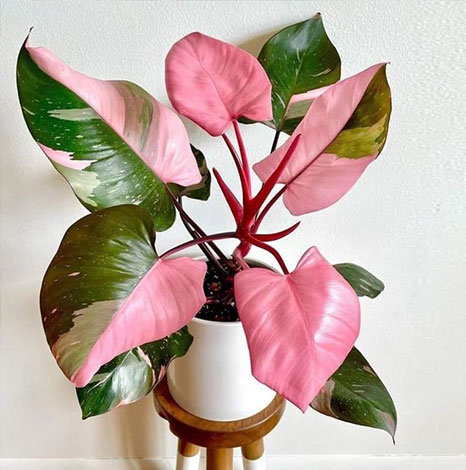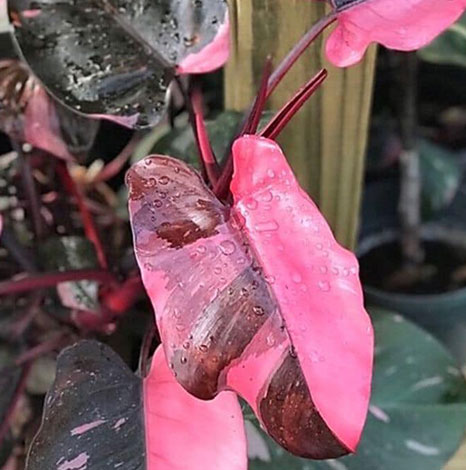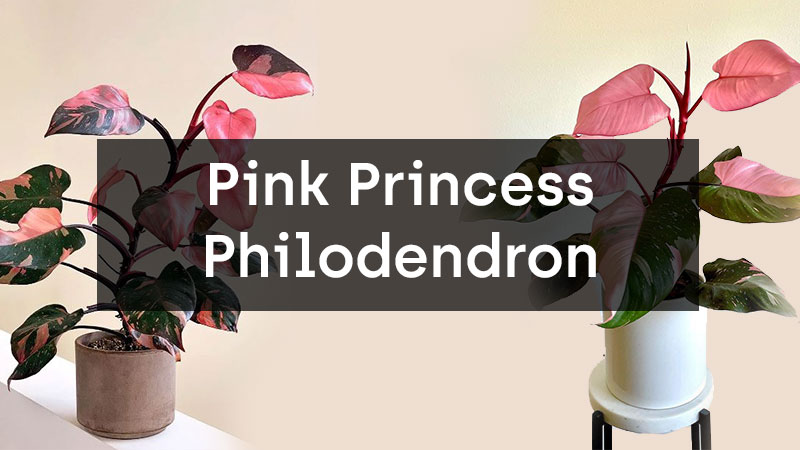Table of Contents
- Introduction
- What is Pink Princess Philodendron?
- Why Choose Pink Princess Philodendron?
- Growing Conditions for Pink Princess Philodendron
- Propagation of Pink Princess Philodendron
- Pruning and Maintenance
- Common Pests and Diseases
- Tips for Enhancing Pink Princess Philodendron’s Growth
- Conclusion
- FAQs
Introduction
The Pink Princess Philodendron, scientifically known as Philodendron erubescens, is a tropical plant native to Colombia. It belongs to the Araceae family and is highly sought after for its unique foliage coloration. The leaves of this philodendron are primarily dark green with vibrant pink variegation, making it a visually striking addition to any indoor setting.
What is Pink Princess Philodendron?
Pink Princess Philodendron is a climbing plant that can reach impressive heights if provided with suitable support. It features heart-shaped leaves that exhibit a beautiful blend of green and pink. The variegation patterns can vary from plant to plant, creating a sense of individuality and uniqueness. This philodendron is primarily grown as a houseplant and is favored for its ability to thrive in indoor environments.

Why Choose Pink Princess Philodendron?
There are several reasons why Pink Princess Philodendron is a popular choice among plant enthusiasts. Firstly, its stunning foliage adds a touch of elegance and aesthetic appeal to any room. The contrast between the dark green base color and the vibrant pink variegation creates a visually captivating display.
Additionally, Pink Princess Philodendron is relatively low-maintenance, making it suitable for both beginners and experienced plant owners. With proper care, this philodendron can thrive indoors and bring joy with its beautiful foliage for many years to come.
Growing Conditions for Pink Princess Philodendron
To ensure the healthy growth of your Pink Princess Philodendron, it is crucial to provide it with the right growing conditions. Here are the key factors to consider:
Light requirements
Pink Princess Philodendron thrives in bright, indirect light. It should be placed near a window where it can receive bright but filtered sunlight. Direct sunlight can scorch the leaves, so it’s important to protect the plant from intense rays.
Temperature and humidity
This philodendron prefers temperatures between 65°F and 75°F (18°C to 24°C). It can tolerate slightly lower temperatures but should be protected from frost. Maintaining a moderate level of humidity is beneficial for the plant’s growth, so you may consider using a humidifier or placing a tray of water near the plant to increase humidity levels.
Soil and watering
Pink Princess Philodendron thrives in well-draining soil. A mix of potting soil, perlite, and orchid bark can provide the right balance of moisture retention and drainage. It’s important to allow the top inch of soil to dry before watering the plant. Overwatering can lead to root rot, so it’s better to underwater than overwater.
Fertilizing
Regular fertilization is essential for the healthy growth of Pink Princess Philodendron. During the growing season, from spring to early fall, you can use a balanced liquid fertilizer diluted to half the recommended strength. Apply the fertilizer every two weeks to provide the necessary nutrients for optimal growth.

Propagation of Pink Princess Philodendron
If you want to expand your Pink Princess Philodendron collection or share the plant with friends, propagation is a great option. There are three common methods of propagation for this philodendron:
Stem cutting
To propagate Pink Princess Philodendron through stem cuttings, follow these steps:
- Select a healthy stem with at least two nodes.
- Use a clean, sharp knife or pruning shears to make a clean cut just below a node.
- Remove the lower leaves, leaving only a few leaves at the top.
- Dip the cut end in a rooting hormone, if desired.
- Place the cutting in a jar or glass of water, making sure the nodes are submerged.
- Keep the cutting in a warm and bright location, away from direct sunlight.
- After a few weeks, roots will start to develop. Once the roots are at least an inch long, you can transplant the cutting into a pot with well-draining soil.
Node cutting
Propagation through node cuttings is another effective method. Follow these steps:
- Look for a stem with several nodes.
- Use a clean, sharp knife or pruning shears to make a clean cut just below a node.
- Remove any leaves from the stem, except for a few at the top.
- Plant the node directly into a pot with well-draining soil, burying it about an inch deep.
- Keep the soil slightly moist and provide bright, indirect light.
- The node will start to develop roots and eventually grow into a new plant.
Air layering
Air layering is a more advanced propagation technique that involves creating a rooting chamber on the stem of the plant. Here’s how to do it:
- Select a healthy section of the stem.
- Make a small incision on the stem, just below a node.
- Dust the incision with rooting hormone.
- Wrap the incision with damp sphagnum moss and cover it with plastic wrap.
- Secure the moss and plastic wrap in place with a twist tie or string.
- Monitor the moisture of the moss and keep it damp.
- After a few weeks, roots will start to develop within the moss.
- Once the roots are well-established, carefully cut below the rooting chamber and transplant it into a pot with well-draining soil.

Pruning and Maintenance
To keep your Pink Princess Philodendron looking its best, regular pruning and maintenance are necessary. Here are some key tasks to perform:
Removing dead or damaged leaves
Inspect your plant regularly and remove any dead or damaged leaves. This helps maintain the overall health and appearance of the plant. Use clean pruning shears or scissors to make clean cuts, and be careful not to damage the healthy foliage.
Controlling vine growth
As Pink Princess Philodendron is a climbing plant, it tends to develop long vines. You can control the vine growth by trimming them back. This not only helps maintain a compact shape but also encourages new growth and enhances the plant’s aesthetic appeal.
Supporting the plant
As the plant grows, it may need support to prevent it from trailing or sprawling. You can provide support by using a moss pole or trellis. As the plant climbs, gently tie the vines to the support structure using soft plant ties or twine. This will help the plant maintain an upright and aesthetically pleasing form.
Common Pests and Diseases
Despite being relatively resilient, Pink Princess Philodendron can face a few common pests and diseases. Here are some to be aware of:
Aphids
Aphids are small, sap-sucking insects that can cluster on the undersides of leaves. They can cause wilting and distorted growth. To control aphids, you can spray the affected leaves with a mixture of water and mild dish soap. Alternatively, neem oil or insecticidal soap can be effective against aphids.
Mealybugs
Mealybugs are another common pest that can infest Pink Princess Philodendron. They appear as white, cotton-like clusters on the leaves and stems. To eliminate mealybugs, you can gently wipe them off with a cotton swab soaked in rubbing alcohol. Regularly inspecting your plant and promptly addressing any signs of infestation can help prevent further spread.
Root rot
Overwatering or poorly draining soil can lead to root rot in Pink Princess Philodendron. This fungal infection can cause the roots to decay, leading to yellowing leaves and wilting. To prevent root rot, make sure to use well-draining soil and allow the top inch of soil to dry out between waterings. If root rot occurs, it’s best to repot the plant in fresh soil, trimming away any affected roots.
Tips for Enhancing Pink Princess Philodendron’s Growth
To ensure your Pink Princess Philodendron thrives and exhibits its vibrant foliage to the fullest, consider the following tips:
Using a moss pole
Pink Princess Philodendron is a climbing plant that appreciates support. Providing a moss pole for it to climb not only enhances its growth but also adds an elegant touch to its appearance. The plant will naturally cling to the pole using its aerial roots, creating a visually striking display.
Providing proper support
As the plant grows, make sure to provide additional support for its vines. If left unattended, the vines may become heavy and droop. By gently tying the vines to a trellis or support structure, you can help the plant maintain an upright and tidy appearance.
Regularly cleaning the leaves
Dust and debris can accumulate on the leaves of Pink Princess Philodendron, which can hinder photosynthesis and affect the overall health of the plant. It’s important to regularly clean the leaves by gently wiping them with a damp cloth or using a mild leaf shine spray. This not only keeps the foliage looking fresh but also ensures optimal functioning.
Conclusion
Growing and caring for Pink Princess Philodendron can be a rewarding experience. With its stunning foliage and relatively low-maintenance requirements, this plant is a beautiful addition to any indoor space. By providing the right growing conditions, proper support, and regular maintenance, you can enjoy the vibrant pink variegation and lush growth of Pink Princess Philodendron for years to come.
FAQs
1. Can Pink Princess Philodendron tolerate low light conditions?
Yes, Pink Princess Philodendron can tolerate low light conditions, but it thrives in bright, indirect light. Placing it near a window with filtered sunlight is ideal for optimal growth and vibrant foliage.
2. How often should I water my Pink Princess Philodendron?
Water your Pink Princess Philodendron when the top inch of soil feels dry. It’s important not to overwater the plant as it can lead to root rot. It’s better to underwater than overwater, as this philodendron prefers slightly drier conditions.
3. Can I grow Pink Princess Philodendron outdoors?
Pink Princess Philodendron is primarily grown as a houseplant. However, it can be grown outdoors in suitable climates with warm temperatures and high humidity. It thrives in tropical or subtropical regions where the conditions mimic its native environment.
4. What is the average growth rate of Pink Princess Philodendron?
The growth rate of Pink Princess Philodendron can vary depending on various factors such as light, temperature, and care. On average, it can grow about 6 to 8 inches per year when provided with optimal growing conditions.
5. How long does it take for Pink Princess Philodendron to produce new leaves?
The growth of new leaves depends on the overall health of the plant and the environmental conditions. Under ideal conditions, Pink Princess Philodendron can produce new leaves every few weeks, especially during the growing season.







0 Comments